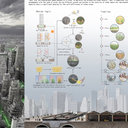Protein-inorganic hybrid nanoflowers as ultrasensitive electrochemical cytosensing interfaces for evaluation of cell surface sialic acid.
Klíčová slova
Abstraktní
The identification of biocompatible nanomaterials with high conductivities as sensing interfaces is important in developing novel electrochemical cytosensors. We prepared a novel protein-inorganic nanomaterial-bovine serum albumin (BSA) incorporated Ag nanoflowers with three-dimensional porous architectures, using a simple biomimetic method. The BSA-incorporated Ag nanoflowers were modified on a glassy carbon electrode (GCE) surface and conjugated with a targeting lectin molecule, i.e., Sambucus nigra agglutinin (SNA), for sensing DLD-1 human colon cancer cells. The BSA-incorporated Ag nanoflowers were a suitable platform, and showed improved cell-immobilization capacity, and good biocompatibility, with retention of activity of the immobilized cells. These properties are attributed to the large surface area of the porous structure and the natural BSA layer acting as a biocompatible support. The attachment of DLD-1 cells to the GCE increased the electron-transfer resistance, with a good correlation with the logarithm of the concentration from 1.35×10(2) to 1.35×10(7) cells mL(-1), with a low detection limit of 40 cells mL(-1). Based on the affinity between SNA and sialic acid (SA), the UV-vis absorption spectrum of the one-step reaction between SA and acidic ninhydrin indicated that the average number of SA molecules on a single living DLD-1 cell surface was approximately 2.16×10(12). This proposed cytosensing strategy had good reproducibility, acceptable precision, and high specificity for SA-over-expressed cells, indicating that it has potential applications for the early monitoring of tumor cells and convenient evaluation of SA on living cells.


